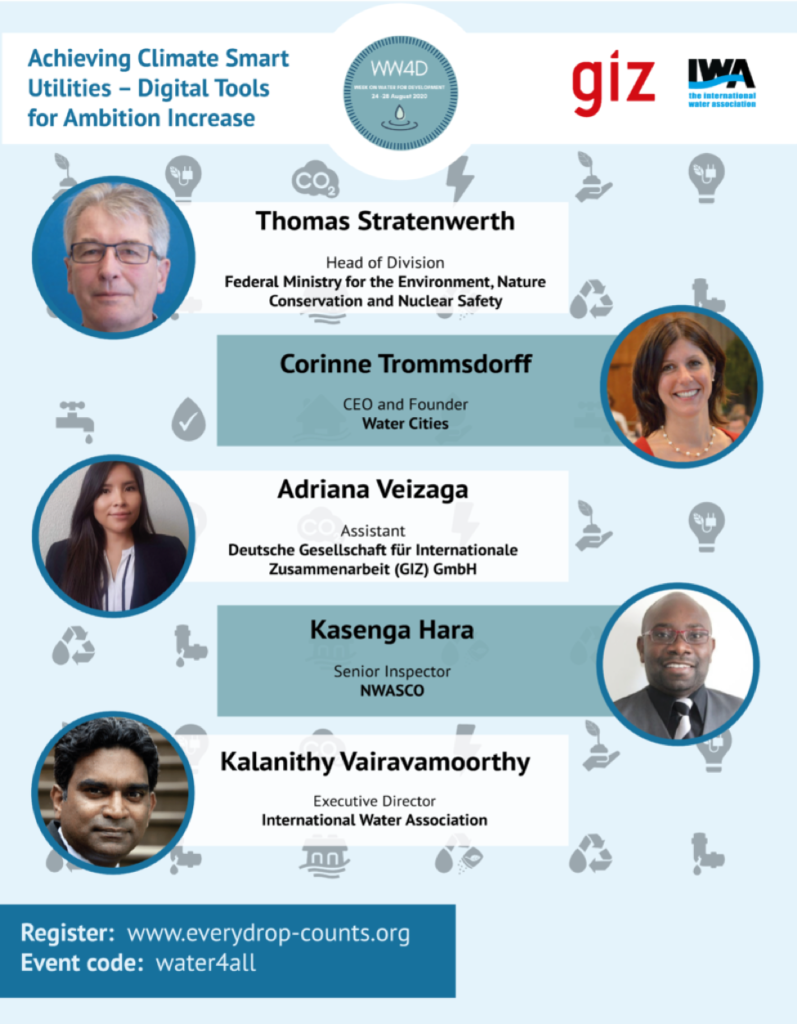Transitioning to Climate Smart Water in Cities
Utilities are starting to adapt as they observe the first impacts of climate change on their operation… but not so many feel the urgency to contribute to reducing the magnitude of this change by reducing their own emissions.
Most of us feel doomed to adapt and not empowered to tackle the source of the problem, as our own potential mitigation actions seem to be a drop in a bucket, and keep being pushed back as low priority under the economic and time constraints that rule our planning.
We all work with priorities. If a plane is about to crash because it runs out of fuel, the engineers do not spend time engineering fuel consumption but focus on advising the pilot to keep the plane flying.
That natural behaviour has been the issue behind the lack of climate action to reduce global GHG emissions, and today water and wastewater utilities find themselves in this scenario: tackling the urgent. The more the adaptation needs become urgent to maintain the service levels, the less bandwidth will the utilities have to invest in the mitigation effort.
We’re seeing this already. For example, facing water scarcity, a utility may in the urgency build massive desalination plants without aggressively reducing its consumption and losses. If it had had more time, it might have first reduced consumptions and losses for a few years and reassessed the desalination need for a smaller less energy-intensive plant.
Utilities make choices to optimise the outputs they are mandated to deliver
Now you may wonder: does it really matter if the utility reduces its carbon footprint, is it a game-changer in the mitigation effort?
Emissions from urban water represent from less than 1% to a few percentages of national emissions depending on the energy mix of the country and the type of treatment, its efficiency, and its ability to produce energy or other resources.
It might seem indeed like a drop in a bucket… However, water utilities, if empowered to take that role, can become catalysts of the local GHG reduction for three reasons:
- They work in partnership with many urban stakeholders and their consumers who also have a small but significant potential to reduce their emissions,
- They can significantly reduce their emissions in some cases up to neutrality if this is set as a target for them,
- The added costs to do this are not very big and in some cases, there is a return on investment; it also opens the door to accessing international climate funding.
Utilities can become the drivers of an accelerated reduction in global emissions. That is the choice that a few countries have made already, but the planet needs a lot more! For example, Jordan has included urban water in its National Determined Contributions to reducing global GHG and Denmark has set a target of carbon neutrality to all their urban water utilities.
Our societies, our planet, are at a crossroad in the way we tackle climate change: we either aggressively reduce our global GHG emissions, which requires to seize every opportunity to reduce, or we continue to feel doomed and powerless to make a dent at reducing emissions, and we accept that we as a global society, will lose lives, decrease the quality of life for many, and spend billions in protection and repair from damages.
Business as usual is not enough, it’s lethal!
Utilities are facing choices when they plan and manage their assets. On wastewater systems, they can compose with an array of solutions that range from conventional energy and concrete intensive approaches to a resource factory approach leveraging nature-based solutions when appropriate. On the water supply side, they can convey water from further away, or reduce losses and consumption, plan more stringent treatments, or protect catchments to improve long term source quality.
What will push the balance towards low-carbon solutions?
- Utilities that have a vision and knowledge on what is possible.
- National regulations and policies, city-level policies and engagements that mandate the utility to also reduce its emissions, in addition to its mission to protect health and the aquatic environment.
- International institutions including climate funds that support utilities with clear guidance.
During the virtual conference Water Week for Development in a session on “Achieving Climate Smart Utilities – Digital tools for Ambition Increase” on 24 August 2020, the speakers shared how the ECAM tool can support utilities in monitoring their GHG emissions, an inspiring example from Zambia of national policy to drive low-carbon solutions, and IWA, presented its Climate Smart Utilities Initiative to support utilities increase their knowledge on how to improve the carbon balance of water and wastewater companies while maintaining or even improving service levels and improving these companies cost-effectiveness.
Adaptation will happen as we start seeing changes but can jeopardize mitigation if we “urgently” have to adapt rather than plan our long-term adaptation. Mitigation can only be the result of a collective effort and therefore needs to be a mandated task, as individual companies will not make this a priority otherwise. It is very difficult to drive change in individual institutions that each make a small contribution to a collective target. It takes visionary leaders, individuals, and companies who have the capacity to implement, and adequate guidance and financial support. Let’s each embrace our responsibilities!
Watch the recorded session “Achieving Climate Smart Utilities – Digital tools for Ambition Increase” at Water Week for Development, 24 August 2020


